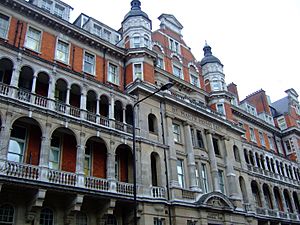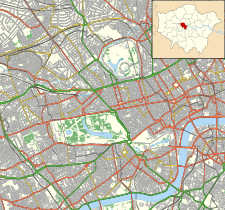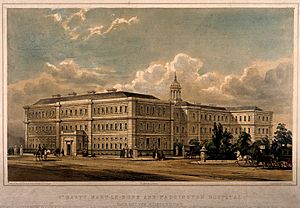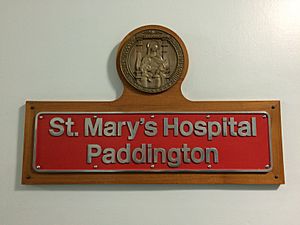St Mary's Hospital, London facts for kids
Quick facts for kids St Mary's Hospital |
|
|---|---|
| Imperial College Healthcare NHS Trust | |

The Clarence Memorial Wing at St Mary's Hospital
|
|
| Geography | |
| Location | Paddington, London, England, United Kingdom |
| Coordinates | 51°31′2″N 0°10′23″W / 51.51722°N 0.17306°W |
| Organisation | |
| Care system | National Health Service |
| Funding | Public hospital |
| Hospital type | Teaching |
| Affiliated university | Imperial College London |
| Services | |
| Emergency department | Major Trauma Centre – (Adult and Children) |
| Beds | 484 |
| History | |
| Founded | 1845 |
St Mary's Hospital is a famous teaching hospital in the Paddington area of London. It was founded way back in 1845. As a teaching hospital, it not only treats patients but also trains future doctors and nurses.
Since 2008, St Mary's has been run by the Imperial College Healthcare NHS Trust. This group also manages other important London hospitals, like Charing Cross Hospital and Hammersmith Hospital.
The hospital has a strong connection with Imperial College London. Its medical school joined with Imperial College in 1988. This means students learn from some of the best doctors and researchers in the country.
Contents
History of the Hospital
St Mary's Hospital first opened to patients in 1851. The original building was designed by the architect Thomas Hopper in a classical style.
A new section, the Clarence Memorial Wing, was added in 1904. This wing faces Praed Street and is a well-known part of the hospital today.
Over the years, St Mary's grew by joining with other local hospitals. This happened after the National Health Service (NHS) was created in 1948 to provide healthcare for everyone in the UK.
In 1987, the nearby Paddington Green Children's Hospital closed, and its services for children were moved to St Mary's.
World-Changing Discoveries
St Mary's Hospital is famous for a discovery that changed the world. In 1928, a scientist named Alexander Fleming was working in his laboratory at the hospital when he discovered penicillin. Penicillin was the first true antibiotic and has saved millions of lives by fighting bacterial infections.
Today, you can visit Fleming's laboratory. It has been turned into a museum where you can learn about his amazing discovery and his life.
The Lindo Wing
In 1937, a special private wing called the Lindo Wing opened. It was named after Frank Charles Lindo, a businessman who gave a large amount of money to the hospital.
The Lindo Wing is famous because many members of the British Royal Family were born there. It is also a popular choice for celebrities.
Famous People Born at St Mary's
Many famous people, including royals and celebrities, were born at the hospital's Lindo Wing.
Royal Births
- William, Prince of Wales (born 1982) – First son of King Charles III and Diana, Princess of Wales.
- Prince Harry, Duke of Sussex (born 1984) – Second son of King Charles III and Diana, Princess of Wales.
- Peter Phillips (born 1977) – Son of Anne, Princess Royal.
- Zara Tindall (born 1981) – Daughter of the Princess Royal.
- Prince George of Wales (born 2013) – First son of the Prince and Princess of Wales.
- Princess Charlotte of Wales (born 2015) – Daughter of the Prince and Princess of Wales.
- Prince Louis of Wales (born 2018) – Second son of the Prince and Princess of Wales.
Other Notable Births
- Elvis Costello (born 1954) – British musician.
- Kiefer Sutherland (born 1966) – Canadian actor.
- Michael Page (born 1987) – British professional boxer and martial artist.
Famous Doctors and Scientists
Many brilliant people have worked or studied at St Mary's. Here are a few of them:
- Alexander Fleming – He won the Nobel Prize for discovering penicillin.
- Roger Bannister – A professor of neurology who was also the first person to run a four-minute mile.
- Almroth Wright – A scientist who made important advances in vaccination.
- J. P. R. Williams – A famous international rugby player for Wales.
- Rodney Robert Porter – He won a Nobel Prize for his research on how antibodies work to fight disease.
- Bernard Spilsbury – A pathologist who was a pioneer in modern forensic medicine, using science to solve crimes.
Special Connections
St Mary's Hospital is right next to London Paddington railway station. To celebrate this connection, a British Rail locomotive (engine number 43142) was named St Mary's Hospital, Paddington in 1986.
The train is still running, but the nameplate was removed. The hospital now has one of the large metal nameplates on display in its Cambridge Wing.
A Center for Serious Injuries
St Mary's is one of London's four major trauma centres. This means it has special doctors and equipment to treat the most serious injuries, like those from major accidents. The other centres are at King's College Hospital, The Royal London Hospital, and St George's Hospital.
Cosmic Charity
A charity called Cosmic helps support the children's intensive care units at St Mary's Hospital. The charity raises money to buy special medical equipment, like ventilators that help babies breathe. It also provides support for the families of sick children.
See also
 In Spanish: Hospital de St. Mary's para niños
In Spanish: Hospital de St. Mary's para niños
- List of hospitals in England




